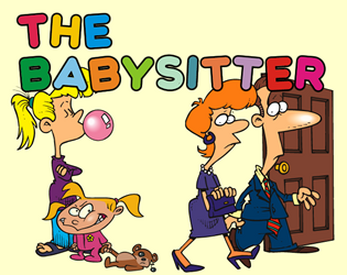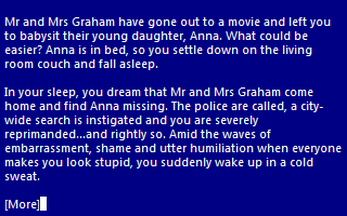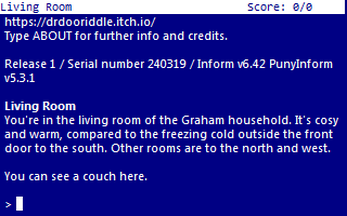
The Babysitter
Introduction
Mr and Mrs Graham have gone out to a movie and left you to babysit their young daughter, Anna. What could be easier? Anna is in bed, so you settle down on the living room couch and fall asleep.
In your sleep, you dream that Mr and Mrs Graham come home and find Anna missing. The police are called, a city-wide search is instigated and you are severely reprimanded...and rightly so. Amid the waves of embarrassment, shame and utter humiliation when everyone makes you look stupid, you suddenly wake up in a cold sweat.
You look around and see that you're still on the couch and everything seems fine. But is it? You had better check on Anna.
Instructions
This is a traditional text adventure based on 'Midnight Emergency' by John H Doolittle.
A text adventure is a form of computer game that presents you with a story. You take on the role of the main character in the story and control that character's actions. The story has a goal and you will need to solve puzzles in order to achieve that goal. The computer tells you where you are, what you can see and what's happening around you. You can then move around, examine the things you find and manipulate those things by telling the computer what to do using simple English commands.
Commands consist of a verb phrase, optionally followed by a noun phrase. Most commands can be abbreviated to a verb followed by a noun. For example, GET THE DIRTY DISHES can be abbreviated to GET DISHES.
If the verb is followed by a preposition, this may alter its meaning. For example, GET LADDER will attempt to pick up the ladder, but GET ON LADDER will attempt to climb onto it.
In some cases, the verb phrase and first noun phrase may be followed by a second noun phrase. The two noun phrases are usually separated by a preposition. For example, HIT DOOR will attempt to hit the door with your hands (as you didn't specify a second noun phrase), but HIT DOOR WITH HAMMER will attempt to hit the door with the hammer. If you only use a verb and a noun, the game will generally tell you if it needs an extra phrase or implicitly try to deduce what is needed for the second phrase.
Don't panic! It's not as complicated as it sounds. Just use simple English sentences starting with a verb and it will all feel quite natural.
Movement
To move around, use commands like GO NORTH and GO SOUTH. You can move in any of the four cardinal compass directions, as well as UP and DOWN. To save typing, these commands can be abbreviated to N, S, E, W, U and D. You can sometimes use other movement commands such as CLIMB, ENTER, EXIT, IN or OUT. These will be reasonably obvious when the time comes.
Examining things
Make sure you EXAMINE everything you come across, even insignificant things like scenery and objects mentioned in room descriptions, as subtle hints and clues are scattered everywhere. To save typing, EXAMINE can be abbreviated to X. For example, EXAMINE COUCH can be abbreviated to X COUCH.
You can also try your other senses when it seems appropriate, e.g. SMELL, TOUCH or LISTEN. Unlike EXAMINE, these actions aren't necessary to solve any puzzles, so don't feel obligated to use them.
Manipulating objects
Apart from examining things, most of your time will be spent manipulating objects. Use commands like GET or TAKE to pick up an object, e.g. GET MOP. Use commands like DROP or DISCARD to drop an object, e.g. DROP MOP. Use WEAR to wear something, e.g. WEAR CLOTHES. Use REMOVE to remove something that is already worn, e.g. REMOVE CLOTHES.
To see what you're currently carrying and wearing, use INVENTORY (or I). As you're not a pack horse, you can only carry ten items at a time.
There are many other verbs that can be used to manipulate objects. These will be fairly obvious when the time comes. Common verbs include OPEN, CLOSE, LOCK, UNLOCK, READ, PUSH, PULL and so on. Use PUT, PLACE or INSERT to put objects into containers or on supporters, e.g. PUT DISHES IN SINK.
Communicating with characters
You may encounter non-player characters in the game, not necessarily human. When you first meet new characters, in addition to examining them, you should try talking to them, e.g. TALK TO GIRL, and asking them questions. However, this particular character is asleep, so you shouldn't wake her.
Advanced features
You can use IT to refer to the noun used in the previous command, e.g. EXAMINE NOTE. READ IT. You can also use HIM, HER and THEM for male, female and plural objects respectively.
You can refer to multiple objects by separating the objects with AND, e.g. GET HAMMER AND NAIL. Using IT in the next command will only refer to the last of those objects, e.g. EXAMINE IT in this example will refer to the nail.
You can use ALL to refer to all the appropriate objects with GET and DROP, e.g. GET ALL to get everything in the current location, GET ALL FROM TABLE to get everything on the table, DROP ALL to drop everything you're holding.
When using ALL, you can use EXCEPT or BUT to exclude some objects, e.g. DROP ALL EXCEPT MOP.
Finally, you can enter multiple commands on the same line by separating them with a period, e.g. UNLOCK DOOR WITH KEY. OPEN IT.
Other commands
Use LOOK (or L) to refresh the display.
Use VERSION to get the game version. Use ABOUT or INFO to get background information and credits for the game. Use CREDITS to get the credits only.
Use SAVE to save your progress. Use RESTORE to restore a previously saved game.
Use UNDO to undo the last move. This is handy if you change your mind or make a mistake. You should not be able to get killed in this game nor should you be able to get into an unwinnable situation. (UNDO is not available with the z3 version of the game.)
Use SCORE to get your current score and number of turns taken. Use FULLSCORE to get your score and a list of the tasks that you've achieved.
Use AGAIN (or G) to repeat the last command.
Use WAIT (or Z) to do nothing apart from pass the time.
Use HELP to get a brief reminder of how to play the game or HINT to get a context-sensitive hint related to the current location.
Use RESTART to restart the game from the beginning. Use QUIT (or Q) to quit without restarting.
Keyboard shortcuts
Some interpreters have keyboard shortcuts. If you are using an interpreter on a computer with a conventional keyboard, most will allow you to press the up and down arrow keys to cycle through your past commands. This is handy if you want to repeat the previous command or correct a typo.
Scoring
You score 20 points for achieving significant tasks. The last task is to return Anna to her bed.
Playing the game
There are two ways to play the game:
Click the 'Run game' button (above) to play the game in a browser.
Download the z5 file and play the game using a z-code interpreter (see below). A z3 file is also provided for old 8-bit and 16-bit computers that can't interpret a z5 file.
Finding a z-code interpreter
There are a variety of z-code interpreters for all the major platforms, as well as many minor and retro platforms. There are far too many to list here. The best source of downloads is probably the Interactive Fiction Archive. Navigate to infocom/interpreters for z-code interpreters and interpreters-multi for interpreters that interpret both z-code games and other formats.
Common z-code interpreters
Android: I recommend Hunky Punk from Google Play. (There are others, as well.)
iOS: I recommend Frotz from the Apple App Store. (There are others, as well.)
Linux: See the links above.
Mac: See the links above.
Windows: I recommend Windows Frotz from the infocom/interpreters link above. (There are others, as well.)
Credits
Inform 6 compiler, language and library originally written by Graham Nelson and now maintained by David Griffith, David Kinder, Andrew Plotkin et al.
PunyInform library written by Johan Berntsson and Fredrik Ramsberg based on the Inform 6 library.
ZAbbrevMaker written by Henrik Åsman.
Parchment interpreter written by Dannii Willis et al.
Original concept by John H Doolittle.
Game design and coding by Garry Francis.
Play testing by Hidnook, Jade J Aincioa, John H Doolittle and Timur Ozturk.
Cartoons in cover image by Ron Leishman of Toonaday.
| Status | Released |
| Platforms | HTML5, Windows, macOS, Linux, Android |
| Rating | Rated 5.0 out of 5 stars (1 total ratings) |
| Authors | DrDooriddle, Garry Francis |
| Genre | Interactive Fiction |
| Tags | Female Protagonist, inform-6, parser, punyinform, Retro, Slice Of Life, text-adventure, Text based |
| Average session | About a half-hour |
| Languages | English |
| Inputs | Keyboard |



Leave a comment
Log in with itch.io to leave a comment.